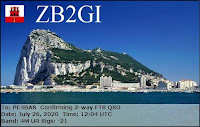 There you go. Just when you think you're a experienced contester you make a big mistake. I got into the shack early in the afternoon and checking out propagation. I noticed some stations that called CQ WW on 20m FT4, so obviously some digital contest was going on. I quickly moved to the settings of WSJT and switched on WW contestmode and started to make contacts. In the mean time I tried to find the rules for this contest. I found a page here:
There you go. Just when you think you're a experienced contester you make a big mistake. I got into the shack early in the afternoon and checking out propagation. I noticed some stations that called CQ WW on 20m FT4, so obviously some digital contest was going on. I quickly moved to the settings of WSJT and switched on WW contestmode and started to make contacts. In the mean time I tried to find the rules for this contest. I found a page here:https://ww-digi.com/rules/. It opens now but at that time I only got a 404 message. So I tried a couple of times but no luck. No problem, I assumed a WW contest always last for 48h so I could continue the fun. Suddenly I noticed there were a lot less stations on air. Well no problem, could be a change of propagation? I also noticed stations did send reports instead of the usual contest exhange, I was confused. Then I found the contest times on a contestcalendar. The contest was over at 11:59 UTC....well it was....12:13 UTC. I'm sorry for those stations I confused....they probabely think I'm still a LID,
Luckely I had some nice QSOs as well. I continued to check propagation and despite there was no SSB/CW signals on the 10m band I saw some stations active on FT8. One station I saw is well known to me but I haven't heard or contacted him for quite a time. It was EI2KC Anthony. We quickly made a FT8 QSO and had a small chat via messenger. Anthony is a well known writer about ancient Ireland and I'm happy to see he updated his blog again recently. So he made a entry into my blogroll again. Well, about 10m QSOs, I recently try to optimize my receive on SSB. The IC-7300 has so many possebilities and filters it is just a way of trying to find the right setting which is personal for everyone. When a signal is just audible it makes a huge difference what filter configuration you use. And in contest situations it could be completely different. So I was listening for small SSB signals on 10m this afternoon when I came across the huge signal from EA7EU Pedro. Actually he was the only SSB signal on the entire 10m (SSB) band. Pedro and I made a nice QSO and connected through twitter to continue and view some photos of his ED7O conteststation. Well, because of the nice contacts I forgot about the mistake made earlier and feel a lot better now...
























